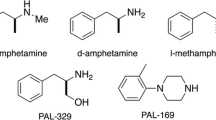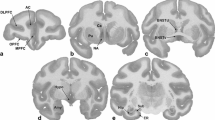Abstract
Rationale
Like other monoamine releasers such as D-amphetamine, chronic treatment with phenmetrazine can attenuate cocaine self-administration in monkeys.
Objectives
The present studies extended this finding to rodents and to cocaine-primed reinstatement, a putative laboratory animal model of relapse.
Methods
In experiment 1, rats self-administered food pellets or injections of 0.19 mg/kg cocaine (i.v.) under a progressive-ratio schedule. When responding was stable, subcutaneous osmotic pumps were implanted containing saline or (+)-phenmetrazine (25 or 50 mg/kg per day). In experiment 2, rats self-administered injections of 0.75 mg/kg cocaine under a fixed-ratio 1 schedule in daily 6-h sessions. When responding was stable, rats were removed from the self-administration environment for 7 days and treated continuously with saline, 5 mg/kg per day D-amphetamine or phenmetrazine (25 or 50 mg/kg per day) via osmotic pumps. Rats were then returned to the self-administration context while treatment continued, and responding was extinguished by removing response-contingent stimulus changes and cocaine injections. Once responding was extinguished, reinstatement tests were conducted using cocaine injections (10 mg/kg i.p.).
Results
Phenmetrazine decreased self-administration of cocaine, but not food pellets, during the 14-day treatment period; effects persisted for several days after treatment was discontinued. Moreover, cocaine-induced increases in responding during the reinstatement test were attenuated by D-amphetamine and both phenmetrazine doses.
Conclusions
These results extend the study of the effects of phenmetrazine on cocaine self-administration to a rodent model, and provide further support for the use of monoamine releasers as agonist medications for cocaine abuse.





Similar content being viewed by others
References
Banks ML, Czoty PW, Nader MA (2007) The influence of reinforcing effects of cocaine on cocaine-induced increases in extinguished responding in cynomolgus monkeys. Psychopharmacology 192:449–456
Banks ML, Blough BE, Negus SS (2011) Effects of monoamine releasers with varying selectivity for releasing dopamine/norepinephrine versus serotonin on choice between cocaine and food in rhesus monkeys. Behav Pharmacol 22:824–836
Banks ML, Blough BE, Fennell TR, Snyder RW, Negus SS (2013a) Effects of phendimetrazine treatment on cocaine vs. food choice and extended-access cocaine consumption in rhesus monkeys. Neuropsychopharmacology 38:2698–2707
Banks ML, Blough BE, Fennell TR, Snyder RW, Negus SS (2013b) Role of phenmetrazine as an active metabolite of phendimetrazine: evidence from studies of drug discrimination and pharmacokinetics in rhesus monkeys. Drug Alcohol Depend 130:158–166
Banks ML, Blough BE, Negus SS (2013c) Effects of 14-day treatment with the schedule III anorectic phendimetrazine on choice between cocaine and food in rhesus monkeys. Drug Alcohol Depend 131:204–213
Banks ML, Blough BE, Negus SS (2013d) Interaction between behavioral and pharmacological treatment strategies to decrease cocaine choice in rhesus monkeys. Neuropsychopharmacology 38:395–404
Barrett AC, Miller JR, Dohrmann JM, Caine SB (2004) Effects of dopamine indirect agonists and selective D1-like and D2-like agonists and antagonists on cocaine self-administration and food maintained responding in rats. Neuropsychopharmacology 47(Suppl 1):256–273
Bouton ME (2004) Context and behavioral processes in extinction. Learn Mem 11:485–494
Cass LJ (1961) Evaluation of phendimetrazine bitartarate as an appetite suppressant. Can Med Assoc J 84:1114–1116
Chait LD, Uhlenhuth EH, Johanson CE (1987) Reinforcing and subjective effects of several anorectics in normal human volunteers. J Pharmacol Exp Ther 242:777–783
Chiodo KA, Roberts DC (2009) Decreased reinforcing effects of cocaine following 2 weeks of continuous d-amphetamine treatment in rats. Psychopharmacology 206:447–456
Chiodo KA, Lack CM, Roberts DC (2008) Cocaine self-administration reinforced on a progressive ratio schedule decreases with continuous D-amphetamine treatment in rats. Psychopharmacology 200:465–473
Corwin RL, Woolverton WL, Schuster CR, Johanson CE (1987) Anorectics: effects on food intake and self-administration in rhesus monkeys. Alcohol Drug Res 7:351–361
Czoty PW, Martelle JL, Nader MA (2010) Effects of chronic d-amphetamine on the reinforcing strength of cocaine in rhesus monkeys. Psychopharmacology 209:375–382
Czoty PW, Gould RW, Martelle JL, Nader MA (2011) Prolonged attenuation of the reinforcing strength of cocaine by chronic d-amphetamine in rhesus monkeys. Neuropsychopharmacology 36:539–547
de Wit H, Stewart J (1981) Reinstatement of cocaine-reinforced responding in the rat. Psychopharmacology 75:134–143
Gerber GJ, Stretch R (1975) Drug-induced reinstatement of extinguished self-administration behavior in monkeys. Pharmacol Biochem Behav 3:1055–1061
Gotestam KG, Andersson BE (1975) Self-administration of amphetamine analogues in rats. Pharmacol Biochem Behav 3:229–233
Grabowski J, Rhoades H, Schmitz J, Stotts A, Daruzska LA, Creson D, Moeller FG (2001) Dextroamphetamine for cocaine-dependence treatment: a double-blind randomized clinical trial. J Clin Psychopharmacol 21:522–526
Grabowski J, Shearer J, Merrill J, Negus SS (2004a) Agonist-like, replacement pharmacotherapy for stimulant abuse and dependence. Addict Behav 29:1439–1464
Grabowski J, Rhoades H, Stotts A, Cowan K, Kopecky C, Dougherty A, Moeller FG, Hassan S, Schmitz J (2004b) Agonist-like or antagonist-like treatment for cocaine dependence with methadone for heroin dependence: two double-blind randomized clinical trials. Neuropsychopharmacology 29:969–981
Griffiths RR, Brady JV, Snall JD (1978) Relationship between anorectic and reinforcing properties of appetite suppressant drugs: Implications for assessment of abuse liability. Biol Psychiatry 13:283–290
Griffiths RR, Brady JV, Bradford LD (1979) Predicting the abuse liability of drugs with animal drug self-administration procedures: psychomotor stimulants and hallucinogens. In: Thompson T, Dews PB (eds) Advances in behavioral pharmacology, vol 2. Academic, New York, pp 163–208
Heal DJ, Buckley NW, Gosden J, Slater N, France CP, Hackett D (2013) A preclinical evaluation of the discriminative and reinforcing properties of lisdexamfetamine in comparison to D-amfetamine, methylphenidate and modafinil. Neuropharmacology 73:348–358
Hutsan PH, Pennick M, Secker R (2014) Preclinical pharmacokinetics, pharmacology and toxicology of lisdexamfetamine: a novel d-amphetamine pro-drug. Neuropharmacology. doi:10.1016/j.neuropharm.2014.02.014, in press
Huttune KM, Raunio H, Rautio J (2011) Prodrugs—from serendipity to rational design. Pharmacol Rev 63:750–771
Jain NC, Budd RD, Sneath TC (1979) Frequency of use or abuse of amphetamine-related drugs. Am J Drug Alcohol Abuse 6:53–57
Katz JL, Higgins ST (2003) The validity of the reinstatement model of craving and relapse to drug use. Psychopharmacology 168:21–30
Keiflin K, Isingrini E, Cador M (2008) Cocaine-induced reinstatement in rats: evidence for a critical role of cocaine stimulus properties. Psychopharmacology 197:649–660
Mooney ME, Herin DV, Schmitz JM, Moukaddam N, Green CE, Grabowski J (2009) Effects of oral methamphetamine on cocaine use: a randomized, double-blind, placebo-controlled trial. Drug Alcohol Depend 101:34–41
Morgan D, Smith MA, Roberts DC (2005) Binge self-administration and deprivation produces sensitization to the reinforcing effects of cocaine in rats. Psychopharmacology 178:309–316
Myers KM, Davis M (2002) Behavioral and neural analysis of extinction. Neuron 36:567–584
Negus SS (2003) Rapid assessment of choice between cocaine and food in rhesus monkeys: effects of environmental manipulations and treatment with d-amphetamine and flupenthixol. Neuropsychopharmacology 28:909–931
Negus SS, Henningfield J (2014) Agonist medications for the treatment of cocaine use disorder. Neuropsychopharmacology. doi:10.1038/npp.2014.322
Negus SS, Mello NK (2003a) Effects of chronic d-amphetamine treatment on cocaine- and food-maintained responding under a progressive-ratio schedule in rhesus monkeys. Psychopharmacology 167:324–332
Negus SS, Mello NK (2003b) Effects of chronic d-amphetamine treatment on cocaine- and food-maintained responding under a second-order schedule in rhesus monkeys. Drug Alcohol Depend 70:39–52
Negus SS, Mello NK, Blough BE, Baumann MH, Rothman RB (2007) Monoamine releasers with varying selectivity for dopamine/norepinephrine versus serotonin release as candidate “agonist” medications for cocaine dependence: studies in assays of cocaine discrimination and cocaine self-administration in rhesus monkeys. J Pharmacol Exp Ther 320:627–636
Negus SS, Baumann MH, Rothman RB, Mello NK, Blough BE (2009) Selective suppression of cocaine- versus food-maintained responding by monoamine releasers in rhesus monkeys: benzylpiperazine, (+)phenmetrazine, and 4-benzylpiperidine. J Pharmacol Exp Ther 329:272–281
Odum AL, Shahan TA (2004) D-amphetamine reinstates behavior previously maintained by food: importance of context. Behav Pharmacol 15:513–516
Peltier RL, Li DH, Lytle D, Taylor CM, Emmett-Oglesby MW (1996) Chronic d-amphetamine or methamphetamine produces cross-tolerance to the discriminative and reinforcing stimulus effects of cocaine. J Pharmacol Exp Ther 277:212–218
Richardson NR, Roberts DCS (1996) Progressive ratio schedules in drug self-administration studies in rats: a method to evaluate reinforcing efficacy. J Neurosci Methods 66:1–11
Rothman RB, Baumann MH (2003) Monoamine transporters and psychostimulant drugs. Eur J Pharmacol 479:23–40
Rothman RB, Katsnelson M, Vu N, Partilla JS, Dersch CM, Blough BE, Baumann MH (2002) Interaction of the anorectic medication, phendimetrazine, and its metabolites with monoamine transporters in rat brain. Eur J Pharmacol 447:51–57
Rush CR, Stoops WW (2012) Agonist replacement therapy for cocaine dependence: a translational review. Future Med Chem 4:245–265
Shaham Y, Shalev U, Lu L, de Wit H, Stewart J (2003) The reinstatement model of drug relapse: history, methodology and major findings. Psychopharmacology 168:3–20
Shearer J, Wodak A, van Beek I, Mattick RP, Lewis J (2003) Pilot randomized double blind placebo-controlled study of dexamphetamine for cocaine dependence. Addiction 98:1137–1141
Steer C, Froelich J, Soutullo CA, Johnson M, Shaw M (2012) Lisdexamfetamine dimesylate: a new therapeutic option for attention-deficit hyperactivity disorder. CNS Drugs 26:691–705
Stewart J (2000) Pathways to relapse: the neurobiology of drug- and stress-induced relapse to drug-taking. J Psychiatry Neurosci 25:125–136
Thomsen M, Barrett AC, Negus SS, Caine SB (2013) Cocaine versus food choice procedures in rats: environmental manipulations and the effects of amphetamine. J Exp Anal Beh 99:211–233
Wilson MC, Hitomi M, Schuster CR (1971) Psychomotor stimulant self-administration as a function of dosage per injection in the rhesus monkeys. Psychopharmacologia 22:271–281
Wood DM, Emmett-Oglesby MW (1987) Evidence for dopaminergic involvement in tolerance to the discriminative stimulus properties of cocaine. Eur J Pharmacol 138:155–157
Wood DM, Emmett-Oglesby MW (1988) Substitution and cross-tolerance profiles of anorectic drugs in rats trained to detect the discriminative stimulus properties of cocaine. Psychopharmacology 95:364–368
Wood DM, Retz KC, Emmett-Oglesby MW (1987) Evidence of a central mechanism mediating tolerance to the discriminative stimulus properties of cocaine. Pharmacol Biochem Behav 28:4001–406
Acknowledgments
This research was supported by the NIDA grant P50 DA 06634.
Conflict of interest
The authors have no conflicts of interest to declare.
Author information
Authors and Affiliations
Corresponding author
Rights and permissions
About this article
Cite this article
Czoty, P.W., Tran, P., Thomas, L.N. et al. Effects of the dopamine/norepinephrine releaser phenmetrazine on cocaine self-administration and cocaine-primed reinstatement in rats. Psychopharmacology 232, 2405–2414 (2015). https://doi.org/10.1007/s00213-015-3875-4
Received:
Accepted:
Published:
Issue Date:
DOI: https://doi.org/10.1007/s00213-015-3875-4




